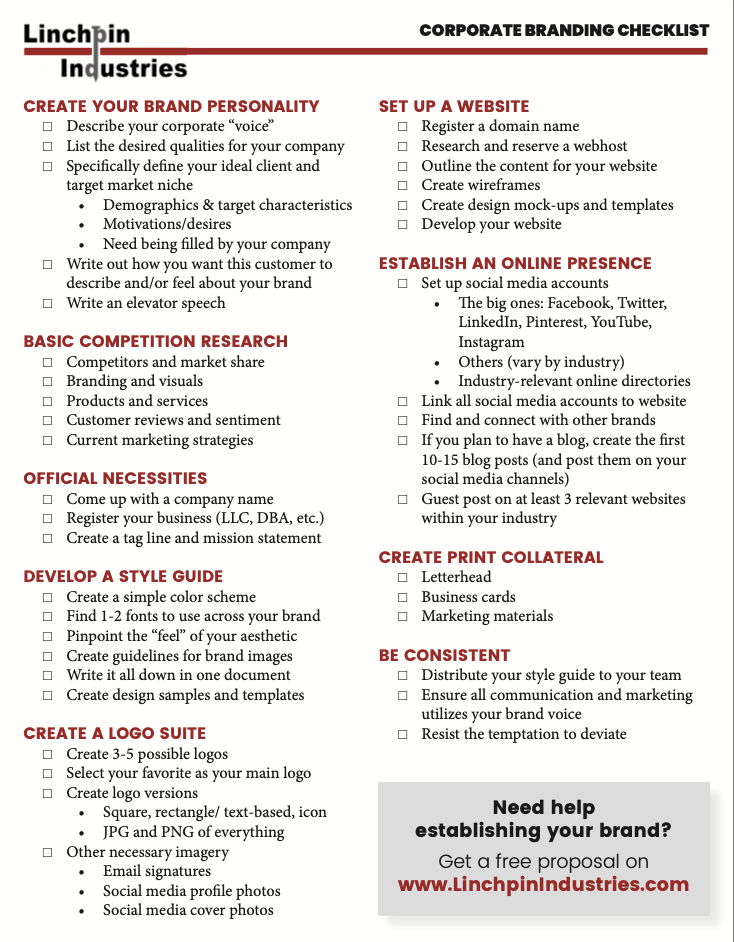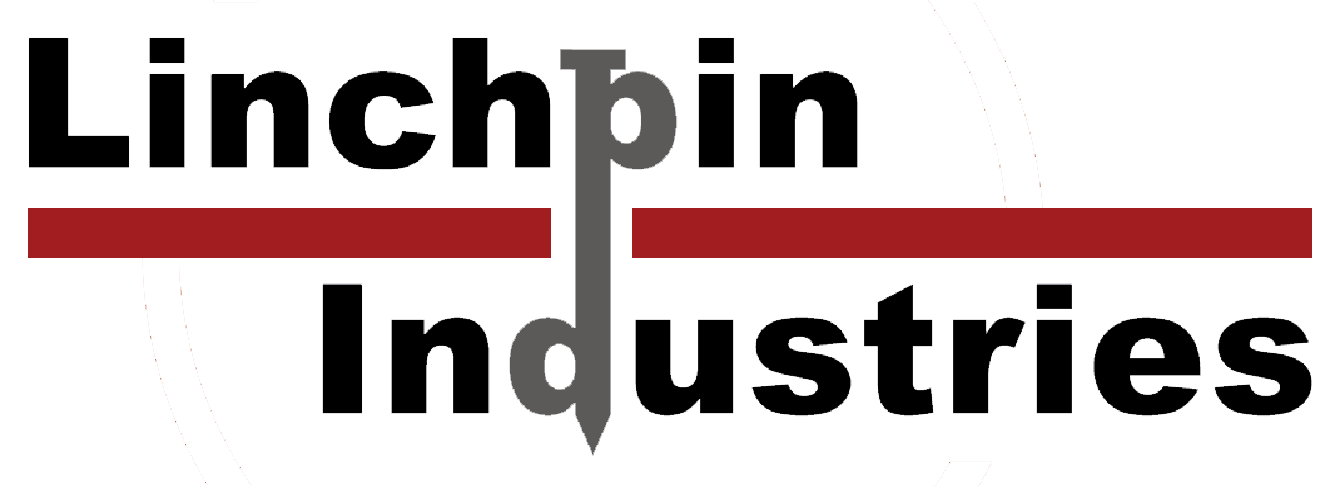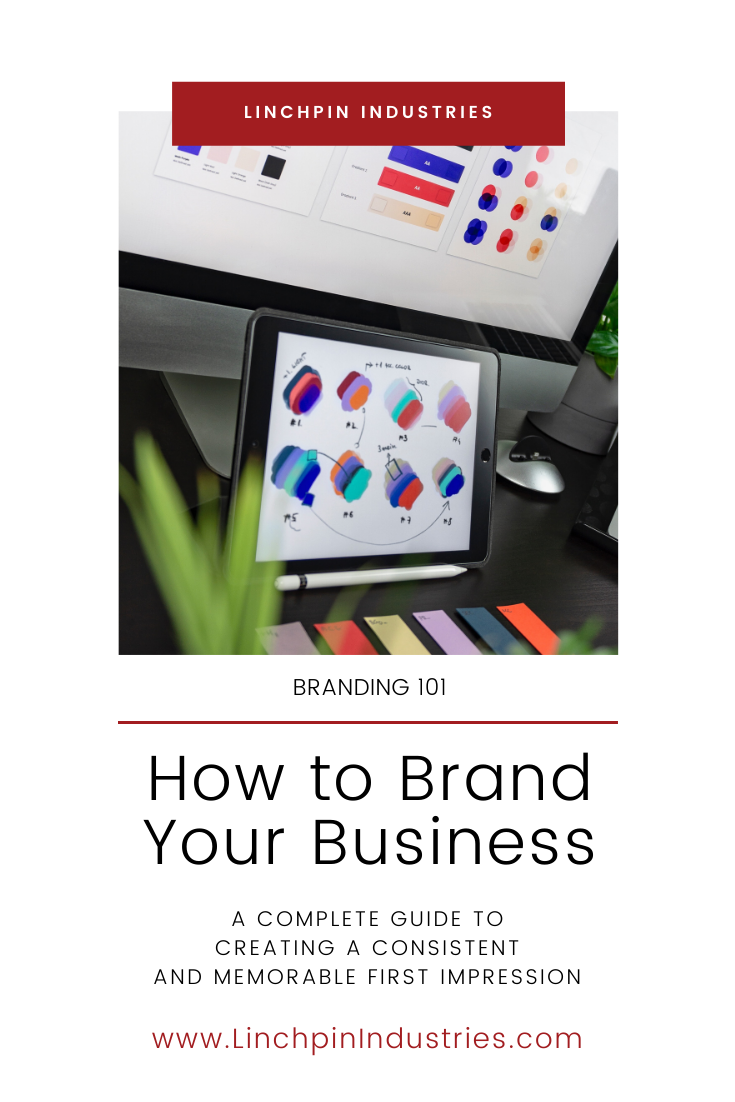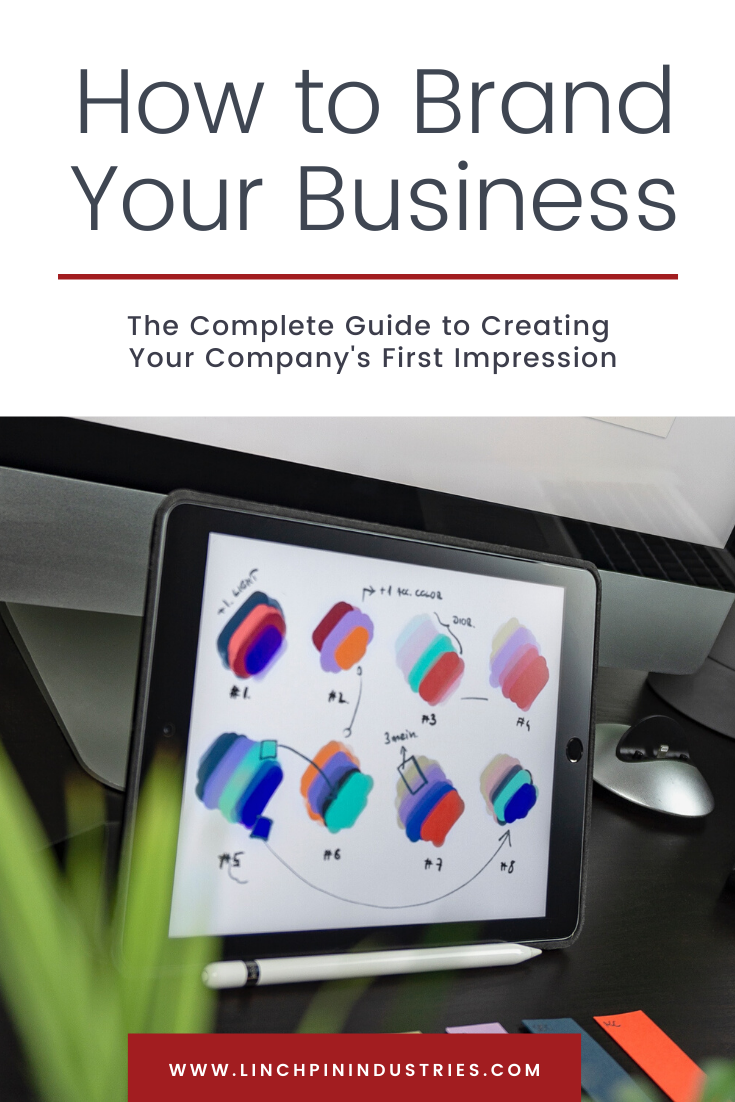
Strategy
How to Brand Your Business
Branding is the way your company shows its personality to the world.
Read More Get My Printable ChecklistTable of Contents
Why is Consistent Branding Important?
What Makes for Successful Branding?
What Do I Need to Do to Brand My Business?
Step 1: Create Your Brand Personality
Step 7: Establish an Online Presence
When you first start a business all you hear about is how you need to "brand yourself" or "brand your business", but for most first-time entrepreneurs this isn't something that is incredibly obvious how to do.
Branding has become a bit of a keyword, both in the business world and in common conversation. Business experts talk about the necessity of consistent branding for a company to succeed and friends speak out against self-deprecation by saying "don't damage your brand".
But what does branding really entail?
What is Branding?
According to the American Marketing Association:
A brand is a name, term, design, symbol, or any other feature that identifies one's seller's good or service as distinct from those of other sellers.
So basically your brand is a cohesive set of qualities, characteristics, or visual demarcations (i.e. logos, colors, etc.) that let customer's know that a specific product or service comes from you instead of your competition.
Logically then, branding is the act of creating a cohesive and effective brand.
Why is Consistent Branding Important?
In the "good old days" where 99% of all sales occurred in brick and mortar stores, it was pretty easy (or at least a great deal simpler) to ensure customers got the right first impression when they walked into your store. If you ensured everything was clean, decorated the store to reflect your company, and greeted the customer with a smile they were sure to get a good first impression of your business.
However, in modern days there is an almost unlimited number of ways your target customer could come upon your company for the first time.
Even if you're a brick and mortar store, a customer could see one of your social media posts, google your general area (e.g. "shoe shops near me") and see your company's website, customer photos, or Yelp reviews. They could see a digital advertisement for your company on another website they frequent. They could hear about you from a friend or see a press release online. And, yes, they can still walk by your store with their actual physical body (gasp).
While it was simple to control the impression you gave off from a simple walk-in experience, a company now has to make sure that (no matter what different channel or method a customer first encounters it) they always have the same, positive first impression and the company is always represented accurately.
If customers that find out about you through your website think of you as an old-timey, personable type of operation and then walk into a physical location that is sleek, modern, and to-the-point professional it might be a little confusing or offputting for them. Similarly, if your social media projects an intellectual, knowledgeable, and forward-thinking company yet your email list is written using humor, slang, and common vernacular it might create a disconnect that could disrupt customer trust or confidence.
Overall, the act of intentionally "branding" your company is to make sure that no matter how or when your customers find you, they get an immediate, accurate, and memorable snapshot of what your company is really like.
The act of intentionally "branding" your company is to make sure that no matter how or when your customers find you, they get an immediate, accurate, and memorable snapshot of what your company is really like.
Tweet ThisWhat Makes for Successful Branding?
The best way to show what makes branding effective is to look at successful instances of companies that have really done it right.
The Power of Logos
The most obvious examples of branding usually revolve around recognizable logos. Let's do an experiment. Check out this picture:

Unless you've spent the last half-century hiding under a rock, you probably would recognize the Nike swoosh anywhere. Most people would say that's "branding".
However, while logo design is one of the most visible parts of a company's brand, it's by no means the most important part.
Look at the Nike swoosh again. What does it make you think of? Running? Football? Playing team sports as a child? Long, sweat-drenched sessions at the gym? Professional athletes? All of the above?
This is the holy grail of branding. It's not that the Nike logo is instantly recognizable (even though it widely is). The important part is that this seemingly amorphous checkmark has come to symbolize and evoke an entire set of emotions, memories, and feelings in almost anyone who sees it.
Nike has successfully created a cohesive brand so that the mere sight of their logo brings up feelings of athleticism, hustle, and a fair amount of sweat (aka the exact feelings their target customer should have to desire their products). Branding mic drop.
Not Just a Logo
Although a great logo can go a long way, just having a recognizable logo won't take your company all the way to branding success.
Just knowing what a logo means doesn't necessarily help make customers more likely to buy your product. (Just because I know what the Harley Davidson logo looks like doesn't make me any more likely to want to own one.)
The larger goal of branding is to make any mention of or interaction with your company (whether that's seeing the logo, walking by a storefront, or reading a social media post) evoke the same emotional response from your customers every time and, more importantly, to make it so this emotional response puts the customer in the state of mind that they need your product.
Looking back to Nike, we already talked about how just seeing their logo evoked thoughts of athletics, hard work, fitness, and a vague feeling like I should be running right now. It's not that far of a jump from this to the line of thinking that "wouldn't I be so much better an athlete if I was wearing Nike gear".
This is the ultimate goal of branding.
What Do I Need to Do to Brand My Business?
So now that you know what branding is, you need to know how to do it.
Unfortunately, branding isn't one single activity or to-do item that can be checked off. (Ah, that it were so simple.) Branding is actually a whole collection of activities. Even more unfortunately, while some aspects of branding are one-time activities (such as designing a logo or registering your company name), far more of branding is made up of tasks that have to be done consistently, observed, tweaked, and monitored to ensure your brand (aka your company and its key values and beliefs) is being represented properly to the public.
What follows is a guide to the major activities and task categories involved in branding your business.
This is by no means an exhaustive list. Unfortunately, no such list exists, and even if it did it would become outdated in weeks (if not days) as technology, the marketplace, and other best practices evolve.
In each of the following sections, we'll cover the basic areas included in branding a new business, the purpose and goal of each activity, as well as some sample tasks included. For a full list of the major tasks involved in each section, you can download a printable checklist below.
Step 1: Create Your Brand Personality
Before you make any major decisions about your business, you should have a very clear picture of "who" you want your company to be, the values and purpose you want for your business, and the target customer for your services (with all their qualities, needs, pain points, and desires). This means you should spend a significant amount of time brainstorming things like your ideal client, target niche, corporate "voice", and other qualitative aspects of your business.
Many businesses forget or intentionally skip this step because it isn't sexy, lucrative, or all that fun (at least not right away). However, it's important to have these aspects of your brand figured out and nailed down in explicit terms so the rest of your branding reflects who you are as a company.
You wouldn't want to generate and publish a bunch of professional, academic, and thoroughly researched content only to realize that your target customer responds better to a humorous and more conversational approach. (For example, I doubt Wendy's would have garnered any attention for factual information about hamburgers, yet their savage Twitter strategy has earned them a great deal of publicity.)
Check out the printable checklist for a full list of questions that need to be answered, but overall this section is about figuring out who you are as a brand and what's important to your desired customers.
Sample Homework Assignment: Think of your company as a person. What qualities would they have? What would it sound like when they talk? What would be their values and priorities?
Step 2: Competition Research
The next step of branding is to get a good feel for what your competitors are currently doing. This isn't so you can ape their tactics, but so you get a full picture of the competitive ecosystem into which you'll be entering and to understand the niche-specific best practices. If you run a blog geared towards parents or a technology company it may be expected that you tweet or post on Instagram multiple times a day, but if you run a company that primarily serves people over the age of 65 this would be at best a complete waste of time and at worst an excessive annoyance and actual turn off to your customers.
It is, however, important that you do this after you finish the brand definition and brainstorming you did in step one so you aren't unnecessarily influenced by what your competitors are doing. You want to know what you're up against, but retain what makes you unique as a company.
The essential aspect of competition research is that only by knowing what your competitors are doing can you judge the potential value and ROI of different potential courses of action. This is one of the tasks that will be ongoing throughout the life of your company (rather than something you can do once and forget), so get used to keeping an eye on the competitive landscape.
Sample Homework Assignment: Who are your top five competitors? What are their most successful strategies? How do they acquire customers? What social media channels do they use and how often?
Step 3: Business Basics
This includes all the boring, legal and administrative aspects of starting a business. You'll need to come up with a name, register as a business entity, choose an accounting platform, and other such minutiae.
It's important that you perform these tasks after you've done the first two steps because you will want to have pinpointed your identity as a company before you choose important things like your business name, tagline, or mission statement.
Sample Homework Assignment: Write a mission statement targeted to your ideal client that encapsulates who you are as a brand and what value you can bring to them as a potential customer.
Step 4: Create a Logo Suite
This is the thing most people think of when you say "branding".
As discussed above in reference to the Nike swoosh, a logo is an essential part of developing a corporate identity. (It's just not the only part.)
Your logo is like your first impression ambassador to the outside world, so you want to make sure it represents the personality, mission, and voice of your company. There are a few areas here that need mentioning: design aspects, technical details, and usage rules.
Design Aspects
This is the basic look and feel of your logo. It should not only look good as a standalone, but it should also reflect your company. If you're a serious, professional business your logo should have clean lines, easy-to-read fonts (often thin weights and/or serif fonts), and professional colors. If you're going for a more fun or casual vibe you can use cursive or handwriting fonts (in moderation, please) or bright colors. And always remember: no Comic Sans.

The biggest concerns when it comes to logo design are things like:
- Is the logo readable in all sizes (even when very small)?
- How will the logo look on different backgrounds (dark vs. light, etc.)?
- Does it project the same "vibe" as your intended business personality?
- Does it have a color scheme you can comfortably use across a broad range of media (e.g. online, social media, print material, etc.)?
Sample Homework Assignment: Make 3-7 different logos and put them out to some target customers. Have them give blind feedback (aka they don't know anything about your company) on what each logo makes them think of, feel, or guess about your business. At the end have them pick their personal favorite.
Technical Details
This is the nitty gritty of logos. You don't just need a logo, you probably need several permutations of it. Many companies have some or all of these variations:
- A square version of their logo
- An image-only logo (no words)
- A horizontal version (usually with the name of their company included with some kind of graphic)
- A monochromatic logo (aka just black or just white) that looks good on any background
- A "favicon" (aka the small logo you see on your browser tab when you go to a website)
It would be a crazy mistake to have each of these as different, stand-alone logos. It would confuse your customers (heck, and your employees). The goal is to have enough different ways of transforming your one logo so that it can work in any situation you might encounter. If you aren't sure what you need, think about the cases of use. You should have a logo that works for:
- Main marketing purposes
- The header of your website
- Social media profile pictures
- Print media or collateral
- Any products that will bear your logo
- Black and white communications (faxes, etc.)
Let your need come up with what permutations you need, but remember that having too many is just as bad as too few. Whatever logo variations you have should have style guidelines (discussed below) to ensure they're used consistently by your entire team.
Sample Homework Assignment: Make a list of all the different places you know you're going to need a logo. From this, make a list of the different logo variations you need to design.
Usage Rules
Logo usage rules are neither fun nor sexy, but they are absolutely essential.
They are especially important if you're working on a team or in a larger company, but even if it is just you running a one-man show it's still a good idea to develop a clear set of instructions for how your logo can and cannot be used.
This is stuff like:
- When should you use each variation (i.e. all social media profiles are logo X, but all print media uses logo Y, etc.)?
- If you have color variations of your logo, which is used where?
- Can your logo be resized?
- Can your logo be rotated?
- Can part of your logo be cropped?
This will likely evolve as you go along, but having a set of default usage rules will save you a great deal of headache as you start creating content and setting up your online presence.
Sample Homework Assignment: Think of a sample list "do and don't" list for how to treat your logo. Try to think like an intern and see what dumb mistakes need preventing.
Step 5: Develop a Style Guide
This one is really an extension of the process you went through with the logo usage rules discussed above. According to Venngage:
A brand style guide is a rulebook containing specifications on everything that plays a role in the look and feel of your brand.
As you create content, establish a presence online, and begin to get the word out about your new company, you want to have one cohesive feel to everything you do. If you don't create a style guide this will eventually evolve naturally, but it will be through a costly (in terms of money spent and potential customers lost) trial and error process.
Practically speaking, a style guide should involve at least the following:
- Specific fonts to use (and when)
- Brand colors (shown as RGB and CMYK values), when to use them, and how not to use them
- Logo variations and their usage (and examples of what not to do)
- Spacing rules for logo, text, and image placement
- Guidance as to brand voice
- Guidelines for images
Basically, anyone who has access to your style guide should have enough information to be able to work up a piece of content that is 100% "on brand" for your company.
This can change over time, but the more specific you get and the sooner this document is developed, the better off you'll be. No one wants to have to constantly retrain all their employees as they make yet another spur-of-the-moment font change. Set up a clear set of rules and guidelines and then stick to it as much as you can. It will create an easier workflow as well as a more consistent message to your customers.
Sample Homework Assignment: Create a style guide rough draft. Work through the questions listed above and see how specific you can get.
Step 6: Set Up a Website
At the time of writing it's 2020. We all thought we'd have hovercrafts by now. Your company needs a website. Period.
Customers use the internet in 97% of their purchasing decisions, so even if you have a purely brick and mortar business, you still need to have at least a cursory website. Even if it's small, it should be mobile-friendly, quick-loading, up-to-date, and professional-looking.
The good news, that's not actually that hard to do. Our web team at Linchpin Industries can usually set up a basic, static information site for under $100. Buying a domain name is usually between $8 and $12 a year. Our hosting plan for this website is $7 a month.
Setting up a website is essential and it is not prohibitively expensive.
Plus, it's 2020. You need a website. Really.
Figure out just what information would be useful to your customers on a website.
Common Newbie Mistake: This isn't show-and-tell. Make sure your website is centered around giving your ideal customer exactly what they want in the easiest to consume manner possible. Don't make a "look at what we have" website; make a "here's what you want" website.
Sample Homework Assignment: Think of all the information your customer might use a website to find. Make a list of all the things they would Google to find you, what information they would want to see once they click on your site, and then organize this into a logical structure for a website.
Step 7: Establish an Online Presence
Once your company has a website they're officially "online", right?
Wrong.
Unfortunately, having a website is just the first step in establishing an online presence. You most likely need a basic social media presence, there could be some databases (i.e. Yelp, Google Businesses, etc.) for which you need to provide information, you may want to have other sites link to you as a guest expert, and there could be niche-specific places in which you want to make your brand a key figure.
Not all companies have to follow the exact same pathway when it comes to establishing an online presence. A brick and mortar store should definitely have a Google Businesses page to let customers see their location, hours, etc. but they might not need a Twitter account. A blog might consider Instagram or Pinterest to be vital for their customer acquisition but would have no need for a Yelp page.
This is where you go back to your customer research and your competition research. Look for where your customers are searching for your product and be there. Check out where your competitors are focusing most of their efforts. You don't need to copy competitor marketing strategies, but chances are businesses in the same niche will usually have parallel presences when it comes to best practices online.
Sample Homework Assignment: Make a list of your top 3-5 competitors and see where they are listed online. Start by checking their websites, social media, and by doing a basic Google search of their business name.
Step 8: Create Print Collateral
Of all the steps, this one varies the most from business to business. If you run a purely-online business like a blog or SAAS company you might just need business cards and some basic letterhead. If you are going to be heavily promoting a physical product, you might need labels, spec sheets, user's manuals, and other ancillary paperwork. If work as a realtor or coach you'll probably need flyers, pamphlets, and a whole host of other paper collateral.
The hardest part here is picking the right things and pinpointing the quantities you'll need. You want to have enough to be able to carry out your business (and most print material is cheaper the more you order), but you don't want to get so much that your business evolves before it has a chance to use it.
For my money, a startup can't go wrong with a basic set of business cards (in a relatively small quantity) and a design template for letterhead that can be printed with the letter (rather than something you have to order. This should last you through the chaotic first few months, at which point you'll have a better handle on what you actually need and you can make a bigger order.
Sample Homework Assignment: Make a list of the possible types of print collateral your company might need. Separate your list into "need immediately" and "wait" piles.
Step 9: Be Consistent
Here is the most important sentence in this entire article:
All of this branding work you just (hopefully) did is only as powerful as your consistency in utilizing it.
Branding isn't like a light switch that immediately illuminates a room, but rather turning on the air conditioning and then an hour later sitting in a cool house. It takes time, consistency, and continuous effort to get the market to respond to your branding efforts.
It is very hard to create metrics for how well branding is working, but it is a total turn-off to customers when it is absent. Especially in the online world, you would be hard-pressed to trust a company that had a poorly-designed logo with unreadable font, clashing colors on their website, no consistency between tones from one email to another...it just wouldn't seem like one cohesive company.
Especially in the last few years of heavy brand personification, companies are acting more and more like people. A recent example of this is NASCAR's official response to one of their driver's quitting over the confederate flag ban:

This would probably have been an unthinkable level of human sass for a corporation to put out in an "official" communication a decade or two ago, but in today's environment, it has actually won NASCAR a lot of positive attention, just like Wendy's previously-discussed, sarcastic twitter strategy.
We're not saying that online roasts are right for every brand, but that you should know your brand well enough to act fearlessly like yourself in all of your company's actions. Know if your company is the corporate embodiment of the smart friend, the doting dad, the professional colleague, or the Twitter savage and then make sure all of your actions correspond with that decision.
Top-Level Summary
Branding is the essential and continuous act of making sure each of the potential touchpoints your company has with potential customers fully communicates who you are as a business and the value that you have for your target market. Branding is not something that is done once, but that is continuously prioritized and monitored throughout the life of a company.
There are a wide array of branding tactics, tasks, and techniques, but the basic categories include creating your brand personality, conducting basic competition research, incorporating your business, developing a style guide, creating a logo suite, setting up a website, establishing an online presence, creating any necessary print collateral, and (most importantly) being consistent with your branding as you conduct business.
By thoroughly and consistently branding your company, you begin to establish a level of credibility, recognizability, and trust among your potential customers that will generate more consistent business for you in the long term.
Liz Bayardelle, PhD
CTO & Principal at Linchpin Industries
Liz’s specialty is translating complex concepts and in-depth research into understandable action plans. She has 15+ years of digital experience, a PhD in business psychology, and is the co-founder of Linchpin Industries

Take the Next Step

A printable checklist of all the essential tasks that need doing to create a cohesive, authentic brand for your business.





